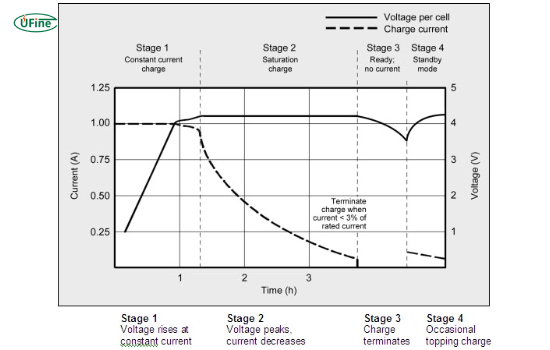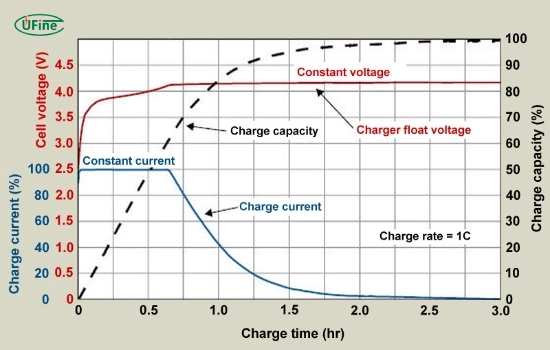The lithium-ion battery has become an integral part of our daily lives, powering an array of devices from smartphones and laptops to electric vehicles.
As these batteries continue to dominate the energy storage landscape, understanding the proper methods for charging them is essential.
This article delves into the intricacies of charging lithium-ion batteries, providing valuable insights to ensure optimal performance and longevity.
Part 1. Lithium-ion battery charging methods
Lithium-ion batteries can be charged using different methods, of which the simpler charging method is constant voltage charging. When using constant voltage charging, the battery voltage remains unchanged, and the charging current will gradually decrease. When the charging current drops below 0.1C, the battery is considered to be fully charged.
To prevent the defective battery from being endlessly charged, this article recommends using a standby timer to terminate the charge cycle. Taking into account the safety and speed of the charging process and the high efficiency of battery use. Lithium-ion batteries usually adopt the constant current and constant voltage charging method, and the charging process can be divided into three stages: pre-charging, constant current charging, and constant voltage charging.
1. Pre-charging stage
In this state, first detect whether the single lithium-ion battery voltage is low (<3.0V), if so, trickle charging is used, that is, a relatively small constant current is used to charge the battery until the battery voltage rises to a safe value. Otherwise, this stage can be omitted, which is also the most common case. Because pre-charging is mainly to complete the repair of the overlaid lithium battery.
2. Constant current charging
After trickle charging, the charger is transferred to a constant current charging state. In this state, the charging current remains unchanged at a larger value, and the maximum charging current of the battery is determined by the capacity of the battery.
In the constant current charging and pre-charging state, by continuously monitoring the voltage and temperature of the battery, the following two constant current charging termination methods can be used to terminate the constant current charging.
- Maximum battery voltage termination method: When the single lithium battery voltage reaches 4.2V, the constant current charging state should be terminated immediately;
- Maximum temperature termination method of the battery: in the constant current charging process, when the temperature of the battery reaches 60℃, the constant current charging state should be terminated immediately.
3. Constant voltage charging stage
After the constant current charging is over, it is transferred to the constant voltage charging state. In this state, the charging voltage remains constant. Because lithium-ion batteries have relatively high requirements for charging voltage accuracy, the constant voltage charging voltage of a single battery should vary between 1% of the specified value, so the charging voltage of lithium-ion batteries should be strictly controlled. During the constant voltage charging process, the charger continuously monitors the battery’s voltage, temperature, charging current, and charging time.
The commonly used constant voltage charging termination method has the following four methods:
- Maximum battery voltage: When the voltage of a single lithium-ion battery reaches 4.25V, the constant voltage charging state automatically terminates;
- Maximum battery temperature: When the maximum temperature of the lithium-ion battery reaches 60℃, the constant voltage charging state automatically terminates;
- Maximum charging time: To ensure the safe charging of lithium-ion batteries, in addition to setting the highest voltage and temperature, the longest constant voltage charging time should be set, which can ensure the safe charging of lithium batteries in the case of failure of temperature and voltage detection;
- Minimum charging current: In the constant voltage charging process, the charging current of the lithium-ion battery gradually decreases, and when the charging current drops to a certain value (usually 1/10 of the constant current charging current), the constant voltage charging state automatically terminates.
Part 2. Lithium-ion battery charger
Lithium-ion battery chargers can be roughly divided into two categories: linear chargers and switching chargers. Although both types can meet the requirements of proper charging of lithium-ion batteries, they each have advantages and disadvantages.
Linear charger
The advantage of a linear charger is that it is relatively simple, but its main disadvantage is that it is inefficient. For example, if the supply voltage is 5V, the battery voltage is 3V, and the charging current is 1A, the power consumption of the linear charger is 2W.
If this charger is embedded in the product, it must emit a lot of heat. This is why most linear chargers are used when the maximum charging current is about 1A.
Switch charger
This charger is the first choice for large batteries. Its advantage is that in some cases its efficiency can be as high as 90%, the disadvantage is that its cost is higher, and because of the use of inductors in the design, the requirement for circuit space is slightly larger.
Part 3. FAQs
-
What is the best way to charge a lithium-ion battery?
The best way to charge a lithium-ion battery is to use a charger specifically designed for that battery type. It’s advisable to avoid frequent deep discharges and instead keep the battery level between 20% and 80% for optimal longevity. Avoid extreme temperatures during charging for better performance. -
How long does a lithium battery take to charge?
The charging time for a lithium-ion battery varies based on factors such as capacity, charger specifications, and the current charge level. Typically, a lithium-ion battery can take a few hours to reach a full charge, but fast-charging technologies can significantly reduce this time. -
What not to do with lithium-ion batteries?
Avoid overcharging, exposing lithium-ion batteries to extreme temperatures, and subjecting them to physical damage. Also, it’s essential not to puncture or disassemble lithium-ion batteries, as this can lead to safety hazards, including fire or leakage of harmful substances. -
Do I need a special charger for lithium batteries?
Using a charger specifically designed for lithium-ion batteries is recommended. These chargers are equipped to deliver the correct voltage and current, preventing overcharging and optimizing the battery’s lifespan. Using an incompatible charger can lead to safety risks and damage to the battery. -
How do you prolong the life of a lithium-ion battery?
To prolong the life of a lithium-ion battery, avoid deep discharges and frequent full charges. Keep the battery level between 20% and 80% for regular usage. Store the battery in a cool, dry place, and avoid exposing it to extreme temperatures. Using a quality, compatible charger and following manufacturer guidelines for charging and storage contribute to maximizing the battery’s lifespan.
Related Tags:
More Articles

Paper Battery vs. Flexible Battery: What’s the Difference and Which Is Better?
Paper vs. flexible batteries: learn the key differences, benefits, and which power source fits best for wearables, sensors, and smart tech.
What to Know Before Buying a Tiny LiPo Battery for Your Project
Tiny LiPo batteries are powerful and compact. Learn how to choose the right one for your project with specs, safety, and charging tips.
Bloated LiPo Battery: Will It Explode?
Will a bloated LiPo battery explode? Discover the causes, risks, safety steps, and expert tips to avoid disaster and protect your gear. Must-read safety guide!
12V 100Ah Lithium Ion Battery Price: Full Guide
Learn about 12V 100Ah lithium-ion battery price, from cost ranges to best brands, hidden fees, and how to get the best deal. A must-read for smart buyers!
Resistance and Conductivity: What It Means for Your Lithium Batteries
Resistance and conductivity impact lithium battery performance, lifespan, and safety—learn how they work and why they matter.





